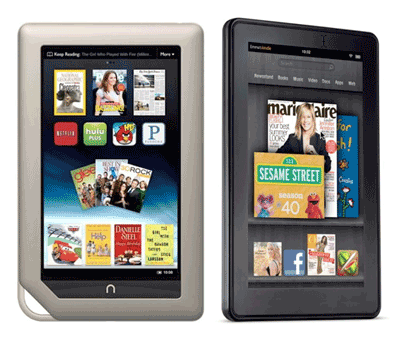Apple iOS tablets experience slip in fourth quarter sales
Affordable tablets begin to cut into company’s dominating grip on market
Will this be the year that Apple and iOS fall out of favor with the tablet-crazed market? Hardly. This report, as put together by the International Data Corporation (IDC), is more so indicative of the massive impact that affordable tablets are beginning to have on the worldwide tablet market.

The low price points for a Barnes & Noble Nook Tablet and Amazon Kindle Fire took away from Apple’s hold of market share. (Via: popherald.com)
The iPad is still the industry leader, but with the continued proliferation of more-affordable, better-running, Android-based tablets, we’ll likely see more balancing of the market over the next few years, rather than an outright fall of one of the industry leaders.
You get a tablet! You get a tablet! EVERYONE GETS A TABLET!
So, let’s get down to brass tacks here: tablet sales rose by 56.1% in the fourth quarter. Manufacturers shipped out 28.2 million units worldwide, which represent a whopping increase of 155% from 2010’s fourth-quarter sales.
As far as 2011 is concerned, the tablet market experienced growth across all different regions and at many different price points. All in all, 68.7 million units were shipped out in 2011.
Based on the strong finish — and the clear demand for the popular device in 2012 — the IDC increased its 2012 forecast for tablet shipments to 106.1 million units, up from its previous estimate of 87.7 million units.
Taking a closer look at the fourth quarter numbers
Apple shipped out more units in the fourth quarter (15.4 million units) than in the third (11.1 million units). Despite increased sales, it loosened its grip on the market: 15.4 million units represented 54.7% of the worldwide market. This is down from the 61.5% market share the company held just a quarter prior.
Perhaps the biggest surprise of the quarter was Amazon, who really cashed in on a low price point, great advertising, and strategically chosen launch date of its tablet device, the Kindle Fire. They shipped a total of 4.7 million units in the fourth quarter, which represented 16.8% of the global market.
Samsung saw a modest increase of its global market share, going from 5.5% in the third quarter to 5.8% in the fourth quarter.
While the Barnes & Noble Nook tablet had the same price point as the Kindle Fire, it did not see the same results. Its market share dropped from 4.5% in the third quarter to 3.5% in the fourth quarter.
Pandigital rounds out the top 5 (for all those who are asking “Who?”, they’re an Android-based line of entry-level tablets that start at $120). In the fourth quarter they held a 2.5% market share, down 0.04% from the quarter prior.
“Amazon’s widely-reported entry into the media tablet market with a $199, 7-inch product seemed to raise consumers’ awareness of the category worldwide despite the fact that the Fire shipped almost exclusively in the U.S. in the fourth quarter,” said Tom Mainelli, research director, Mobile Connected Devices. “As a result, products across the pricing spectrum sold well, including everything from Apple’s premium-priced iPads to Pandigital’s line of Android-based, entry-level tablets.”
Battle of the operating systems
Well, it’s not really a battle, per se; more so, it’s a duel between Android and iOS. And last quarter’s winner was definitely Android.
The growth of Google-based Android can largely be attributed to the big splash that the more affordable tablets made last quarter. The operating system grew its market share from 32.3% in the third quarter to 44.6% in the fourth.
Naturally, this resulted in Apple’s iOS seeing a drop in its market dominance: it went from a third-quarter 61.6% hold to just 54.7% in the fourth.
The other two in the field were nowhere close to these two powerhouses: Blackberry went from 1.1% to 0.7% and WebOS, which had a healthy 5% stake in the market in the third quarter, flat-lined in the fourth, turning a 0% market share in the fourth.
“As the sole vendor shipping iOS products, Apple will remain dominant in terms of worldwide vendor unit shipments,” Mainelli said. “However, the sheer number of vendors shipping low-priced, Android-based tablets means that Google’s OS will overtake Apple’s in terms of worldwide market share by 2015.
We expect iOS to remain the revenue market share leader through the end of our 2016 forecast period and beyond.”
Don’t sleep on eReaders
Despite the growing popularity of tablets, eReaders are still very much relevant in today’s consumer market. They, too, experienced a bigger-than-expected growth in the fourth quarter, which can largely be attributed to the steep price cuts seen in the U.S. and Canada markets, as well as increased shipments in regions outside North America.
Worldwide shipments increased to 10.7 million units in the fourth quarter, up from 6.5 million units in the third. That represents a quarter-over-quarter improvement of 64.6%, and a year-over-year improvement of 64.3%.
IDC expects growth to continue in 2012 as Amazon, Barnes & Noble, and Kobo all look to expand into new international markets.
“Publishers in markets outside of North America are only just beginning to warm up to the idea of eBooks,” Mainelli added. “Once Amazon and others persuade these content owners to embrace digital formats, we expect eBook reader shipments into these regions to increase more rapidly.”
Via: IDC press release ■
Advertisement
Learn more about Electronic Products Magazine





